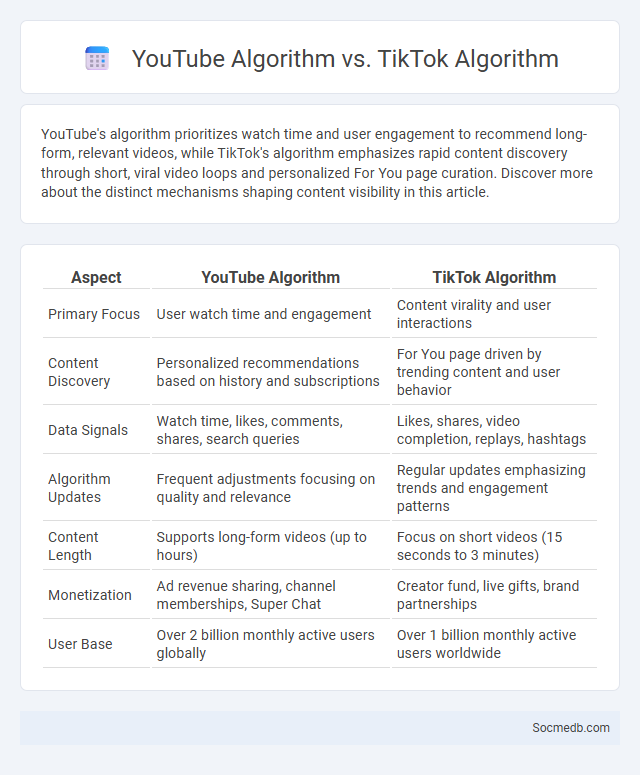
Photo illustration: YouTube Algorithm vs TikTok Algorithm
YouTube's algorithm prioritizes watch time and user engagement to recommend long-form, relevant videos, while TikTok's algorithm emphasizes rapid content discovery through short, viral video loops and personalized For You page curation. Discover more about the distinct mechanisms shaping content visibility in this article.
Table of Comparison
| Aspect | YouTube Algorithm | TikTok Algorithm |
|---|---|---|
| Primary Focus | User watch time and engagement | Content virality and user interactions |
| Content Discovery | Personalized recommendations based on history and subscriptions | For You page driven by trending content and user behavior |
| Data Signals | Watch time, likes, comments, shares, search queries | Likes, shares, video completion, replays, hashtags |
| Algorithm Updates | Frequent adjustments focusing on quality and relevance | Regular updates emphasizing trends and engagement patterns |
| Content Length | Supports long-form videos (up to hours) | Focus on short videos (15 seconds to 3 minutes) |
| Monetization | Ad revenue sharing, channel memberships, Super Chat | Creator fund, live gifts, brand partnerships |
| User Base | Over 2 billion monthly active users globally | Over 1 billion monthly active users worldwide |
Introduction to Content Recommendation Algorithms
Content recommendation algorithms analyze Your preferences and online behavior to deliver personalized social media feeds, enhancing engagement and user experience. These algorithms use machine learning techniques to predict content relevance based on factors like past interactions, demographics, and trending topics. By continuously adapting to user feedback, they optimize the visibility of posts tailored to Your interests, increasing time spent on platforms and satisfaction.
How the YouTube Algorithm Works
The YouTube algorithm analyzes user behavior, including watch time, likes, comments, and sharing patterns, to personalize video recommendations and maximize engagement. It prioritizes videos with high viewer retention and relevance to individual interests, using machine learning models to predict content users are most likely to watch next. By continuously updating based on real-time data, the algorithm ensures dynamic content delivery tailored to evolving viewer preferences.
Understanding TikTok’s Recommendation System
TikTok's recommendation system leverages machine learning algorithms to analyze user interactions, video information, and device accounts to curate personalized content feeds. The AI prioritizes factors such as watch time, likes, shares, and comments, creating a highly engaging and tailored user experience. This dynamic algorithm adapts continuously to evolving user behaviors, making TikTok's For You Page a powerful tool for content discovery and viral growth.
Key Differences Between YouTube and TikTok Algorithms
YouTube's algorithm prioritizes watch time, user retention, and personalized video recommendations based on long-form content engagement, promoting videos that keep viewers on the platform for extended periods. TikTok's algorithm emphasizes short-form content discovery through rapid trend detection, user interaction signals such as likes, shares, and completion rates, leading to viral video promotion on the For You Page. Unlike YouTube's focus on subscriber growth and detailed searchability, TikTok leverages machine learning for instant content relevance tailored to individual user behavior patterns.
Factors Influencing Video Recommendations
Algorithms analyze your viewing history, engagement patterns, and watch time to tailor video recommendations uniquely to your preferences. Factors such as video metadata, user demographics, and trending content also play a crucial role in shaping the suggestions you receive. Understanding these variables helps optimize your social media experience and discover relevant videos more efficiently.
User Engagement Metrics Compared
User engagement metrics such as likes, comments, shares, and time spent on posts provide critical insights into audience interaction on social media platforms. Platforms like Instagram and Facebook typically report higher average engagement rates compared to Twitter, where rapid content turnover limits deep user interaction. Tracking metrics like click-through rates and follower growth further enhances understanding of content performance and audience loyalty.
Personalization Techniques: YouTube vs TikTok
YouTube utilizes sophisticated algorithms analyzing watch history, search queries, and user engagement to deliver personalized video recommendations, optimizing viewer retention. TikTok's personalization hinges on its For You Page algorithm, which rapidly adapts using machine learning to assess interactions like likes, shares, and watch time, crafting a highly tailored, immersive content feed. Both platforms leverage vast user data, but TikTok emphasizes real-time content discovery, whereas YouTube focuses on long-term user preferences.
Content Discovery and Virality
Content discovery on social media platforms leverages advanced algorithms to personalize your feed, promoting relevant posts that maximize engagement and reach. Virality is driven by a combination of timely trends, shareable content formats, and network effects that amplify visibility across diverse audiences. Understanding these dynamics helps you optimize your strategy to achieve exponential growth and brand awareness.
Algorithm Transparency and User Control
Algorithm transparency in social media empowers users by revealing how content is prioritized and personalized. Increased user control over algorithms allows customization of feeds, promoting a more tailored and less biased experience. Platforms implementing transparent practices and adjustable settings foster trust and enhance user engagement.
Future Trends in Video Platform Recommendations
Future trends in video platform recommendations emphasize AI-driven personalization, leveraging deep learning algorithms to analyze user behavior and preferences for highly tailored content suggestions. Enhanced cross-platform integration allows seamless content discovery across devices, boosting engagement and user retention. Emerging technologies like augmented reality (AR) and virtual reality (VR) are increasingly integrated into recommendation systems, enriching user interaction and immersive experiences.
 socmedb.com
socmedb.com